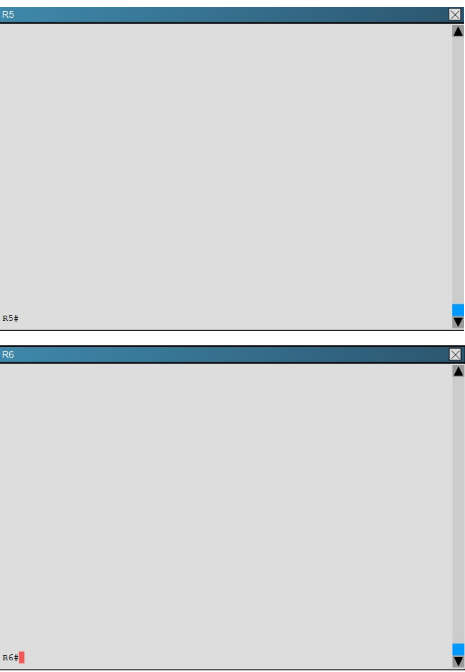| Question ID 13446 | Scenario:
You have been brought in to troubleshoot an EIGRP network. You have resolved the initial
issue between routers R2 and R4, but another issue remains. You are to locate the
problem and suggest solution to resolve the issue.
The customer has disabled access to the show running-config command.




The network segment between R2 and R4 has become disconnected from the remainder
of the network. How should this issue be resolved?
|
| Option A | Change the autonomous system number in the remainder of the network to be consistent with R2 and R4.
|
| Option B | Move the 192.168.24.0 network to the EIGRP 1 routing process in R2 and R4.
|
| Option C | Enable the R2 and R4 router interfaces connected to the 192.168.24.0 network.
|
| Option D | Remove the distribute-list command from the EIGRP 200 routing process in R2.
|
| Option E | Remove the distribute-list command from the EIGRP 100 routing process in R2.
|
| Option F | Answer : B
Explanation: When issuing the show ip eigrp neighbor command (which is about the only command that it lets you do in this question) you will see that all other routers are configured for EIGRP AS 1. However, the 192.16824.0 network between R2 and R4 is incorrectly configured for EIGRP AS 100:

|
| Correct Answer | B |
| Question ID 13447 | Scenario:
You have been asked by your customer to help resolve issues in their routed network.
Their network engineer has deployed HSRP. On closer inspection HSRP doesn't appear to
be operating properly and it appears there are other network problems as well. You are to
provide solutions to all the network problems.



The following debug messages are noticed for HSRP group 2. But still neither R1 nor
R2 has identified one of them as standby router. Identify the reason causing the
issue.
Note: only show commands can be used to troubleshoot the ticket.
R1#
'Mar 26 11:17:39.234: HSRP: Et1/0 Grp 2 Hello out 172.16.20.2 Active pri 100 vIP
172.16.20.254
'Mar 26 11:17:40.034: HSRP: EtO/0 Grp 1 Hello out 172.16.10.2 Active prj 130 vIP
172.16.10.254
R1#
'Mar 26 11:17:40.364: HSRP: EtO/0 Grp 1 Hello in 172.16.10.1 Standby pri 100 vIP
172.16.10.254
R1#
'Mar 26 11:17:41.969: HSRP: Et1/0 Grp 2 Hello out 172.16.20.2 Active pri 100 vIP
172.16.20.254
'Mar 26 11:17:42.719: HSRP: EtO/0 Grp 1 Hello out 172.16.10.2 Active prj 130 vIP
172.16.10.254
'Mar 26 11:17:42.918: HSRP: EtO/0 Grp 1 Hello in 172.16.10.1 Standby pri 100 vIP
172.16.10.254
R1#
'Mar 26 11:17:44.869: HSRP: Et1/0 Grp 2 Hello out 172.16.20.2 Active pri 100 vIP
172.16.20.254
'Mar 26 11:17:45.485: HSRP: EtO/0 Grp 1 Hello out 172.16.10.2 Active prj 130 vIP
172.16.10.254
'Mar 26 11:17:45.718: HSRP: EtO/0 Grp 1 Hello in 172.16.10.1 Standby pri 100 vIP
172.16.10.254
R1#
'Mar 26 11:17:47.439: HSRP: Et1/0 Grp 2 Hello out 172.16.20.2 Active pri 100 vIP
172.16.20.254
'Mar 26 11:17:48.252: HSRP: EtO/0 Grp 1 Hello in 172.16.10.1 Standby pri 100 vIP
172.16.10.254
'Mar 26 11:17:48.322: HSRP: EtO/0 Grp 1 Hello out 172.16.10.2 Active prj 130 vIP
172.16.10.254
R1#
'Mar 26 11:17:50.389: HSRP: Et1/0 Grp 2 Hello out 172.16.20.2 Acti
|
| Option A | HSRP group priority misconfiguration
|
| Option B | There is an HSRP authentication misconfiguration
|
| Option C | There is an HSRP group number mismatch
|
| Option D | This is not an HSRP issue: this is DHCP issue.
|
| Option E | The ACL applied to interface is blocking HSRP hello packet exchange
|
| Option F | Answer : E
Explanation: On R1 we see that access list 102 has been applied to the Ethernet 1/0 interface:

|
| Correct Answer | E |